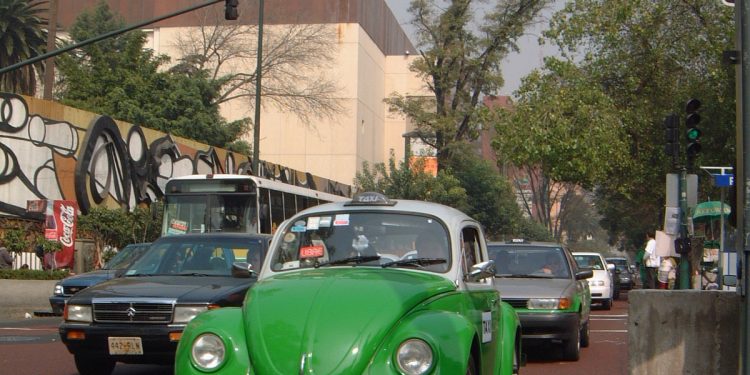For decades, yellow-colored VW Beetle Bugs were an icon of Mexico City’s street landscape. Then, in the 1990s, as part of an ecology-drive, the capital’s government ordered cabbies to have their vehicle engines altered so that they would run on unleaded gasoline, and to repaint them from yellow to green and white.
Some years later, as part of a program to modernize taxi services in the capital and reduce taxi crime, laws were passed forcing Mexico City’s cabbies to operate only four-door cars. Financial incentives were put in place to encourage those drivers who operated the VW Beetles to upgrade, and all new taxi licenses were only issued to owners of four-door vehicles. They also changed the color scheme to white, with a red stripe surround.
Throughout the period of transition, some green and white VW Beetles remained operational. However, officials announced that the last of old Beetle taxi licenses would expire by the end of 2012, and would not be renewed.
With the passing of an era, those who have known Mexico City for decades might take a moment to reminisce about the ‘old days’, when all street cabs were VW Beetles: with the front passenger seat removed, leaving only the bench seat at the back for passengers, and the open space in front for baggage, or even additional passengers—at the taxi driver’s discretion. Beetles were never the safest of taxis to travel in, but were an experience to behold, nonetheless.
The last two decades has witnessed significant transformation in the taxi landscape across Mexico City.
“Sitio” (taxi rank) cabs have always had four doors, even in the old days, but they were more expensive and travelers back then hailed a ‘Vocho’ when they could find one. Today, all cabs are the more comfortable four-door sedans, whether they are tied to a Sitio, or roaming the streets seeking passing trade.
The color scheme has also changed again — twice — since the green beetle-bugs were phased out: street cabs were first painted in a distinct burgundy and gold (and, in a bid to stamp-out taxi-related crime, the city took extensive measures to re-license all taxi vehicles and carefully vet drivers before re-issuing driver permits during this period) and then in late 2014 officials announced a new color scheme for cabs in the capital: white and pink.
Along with the change of vehicles and their livery colors has come changes in the way people hire their taxi ride. While street cabs remain plentiful, very affordable and convenient for ad-hoc trips, increasing numbers of people today phone a taxi company and have a cab pick them up from home and even if they are at out, or from work. More recently, App-Cab services (like Uber and Cabify) — which use a smartphone App to deliver taxis on-demand — have become increasingly popular, especially among the middle-class youth, working professionals, and women.
Fares for cabs arranged by phone and Uber are generally higher than using roaming street cabs, but are still affordable. The growth of taxi cab firms and the advent of universal cell phone and smartphone usage has made it possible to easily arrange ‘cabs on demand’, which is not only safer, but actually more convenient.
While some may lament the final passing of Vocho cabs in Mexico City, the reality is that taxi travel in the capital has improved enormously over the last decade. Taxis are more plentiful, more comfortable, safer, and the extensive choice of taxi firms arranging cabs ‘on demand’ by telephone or by App has created a very healthy and competitive market for cab travel here. Add to this, Mexico City continues to offer residents and visitors some of the lowest fares for taxi travel in any capital city.
Cab drivers in the provinces continue to operate using a plethora of different vehicles (including VW Beetles) and it’s likely that the Bugs will continue to ply the streets of colonial cities like Taxco until they can no longer be physically repaired, or until state legislators take action to retire them, as Mexico City has.
Mexico in your inbox
Our free newsletter about Mexico brings you a monthly round-up of recently published stories and opportunities, as well as gems from our archives.

